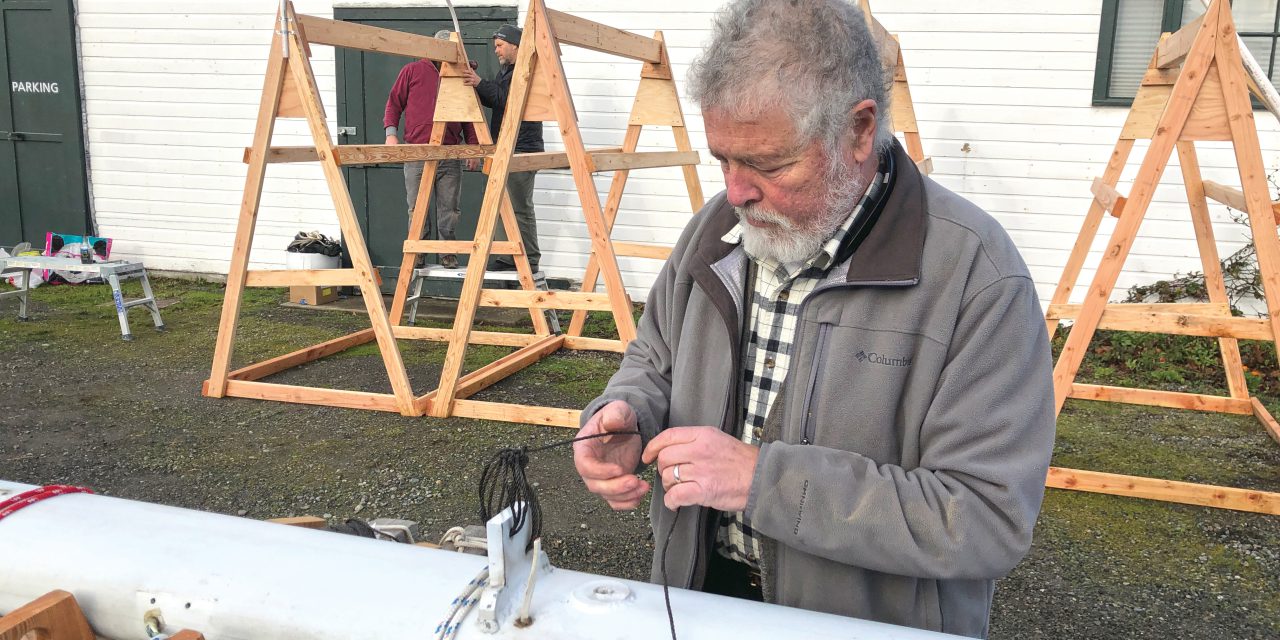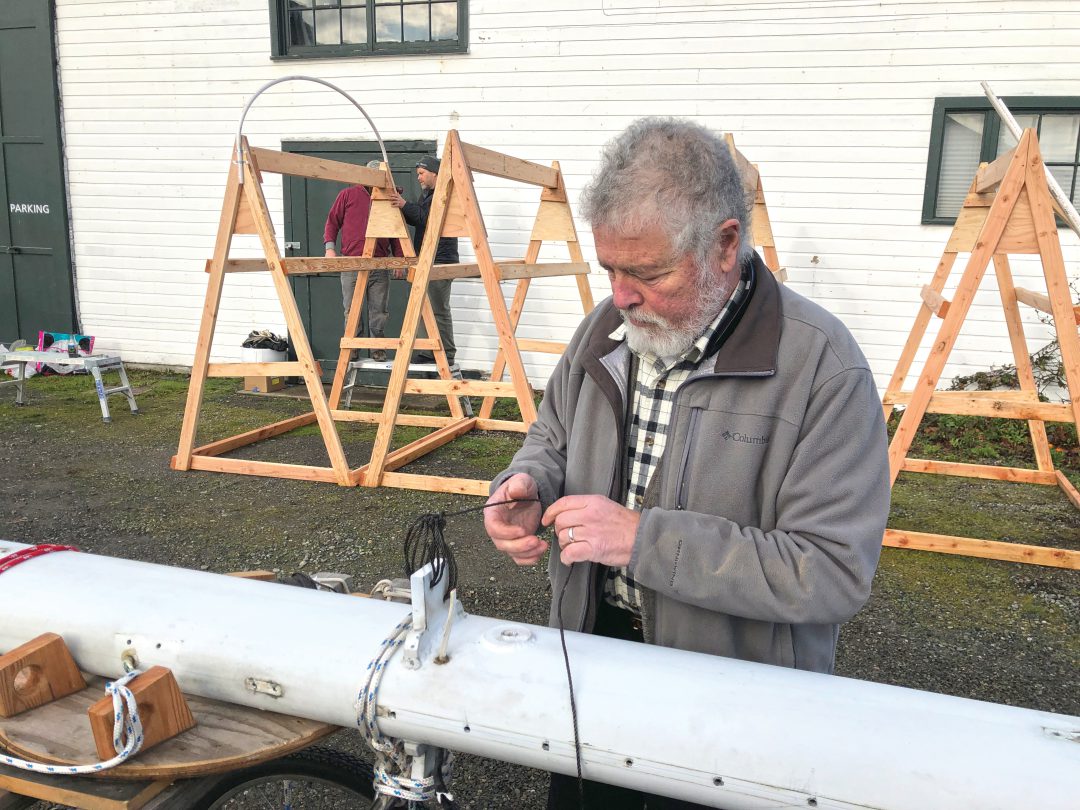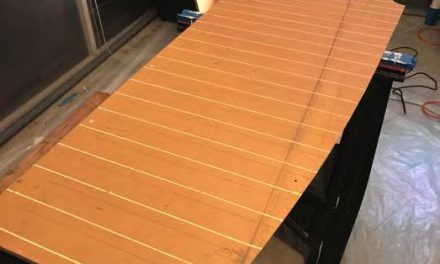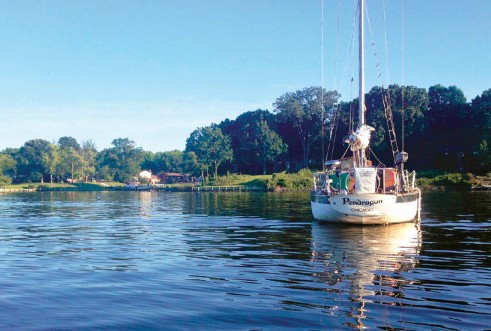How a mast overhaul marked the passing of an icon and a new chapter for a storied rigging loft.
The 60-odd-foot aluminum tube, balanced horizontally on a custom two-wheeled cart, bounced and bent alarmingly as the three of us guided it down the narrow road toward the old shop. I had the lead position in this precarious procession, holding my end of the mast in a wrestler’s headlock, convinced that disaster lay just one misstep away.
As we made the wide turn into the gravel parking lot, I glanced back to see Ian Weedman in the middle pivoting the cart and Brion Toss guiding the bottom of the mast around. They were completely unconcerned. In their many years of working together, the two master riggers had performed this balancing trick countless times. Mast after mast had made the same journey from the haulout dock, down the one-way road, past the two old houses and the giant black Herreshoff cleat large enough to serve as a bench to take in the amalgam of wooden, steel, and fiberglass vessels nestled in Port Townsend, Washington’s historic Point Hudson basin.
But this mast, this trip, was different. I didn’t know it then, but this would be one of the last masts that Brion worked on. And it would be the first one that Ian and the crew who carry on his immense legacy would step during a bittersweet moment several months later.
Over those days and weeks, the mast would be made like new again, the world would be transformed by COVID-19, and a small shop that helped redefine the art of sailboat rigging would suffer a devastating blow and then find the will, continuity, and leadership to move forward.
Meeting Brion
I first met Brion Toss in 1997. The author of the masterpiece The Complete Rigger’s Apprentice had already built a global reputation as a leading thinker, craftsman, and occasional provocateur in the art-meets-science world of modern yacht rigging. I was an inexperienced sailor and first-time boat owner who had enough sense to know that I didn’t know the first thing about whether my mast and rigging were sound.
When I called his shop, Brion Toss Yacht Riggers, to schedule a rig inspection, I was surprised that he picked up the phone himself. He asked about the boat, a 1984 Islander 38C, and what I needed, and then with patience, good grace, and several deadpan jokes, proceeded to answer a flurry of novice questions.
On the appointed date and time, Brion arrived at the boat, his rigger’s kit in hand, and set about his inspection. He had curly hair, a medium build, and a disposition that immediately put you at ease. Over the next few hours, he poked, stretched, and prodded shrouds, sheets, blocks, furlers, cleats, and winches from the base of the mast all the way to the head. Every few minutes he would take a note by speaking into his handheld recorder. And each time, he would pause to show me exactly what he was seeing and why it was a concern, how it could be improved, and, most often, why it was probably nothing to worry about.
It was my first experience in the boating world with a true expert sharing his or her knowledge in ways that helped me begin to understand my sailing vessel, rather than simply owning it.
From that moment on, I considered Brion Toss my rigger. With any question or concern that I had about the mast on that Islander 38C, or on the subsequent boats that came and went in my life, I would turn to Brion for answers.
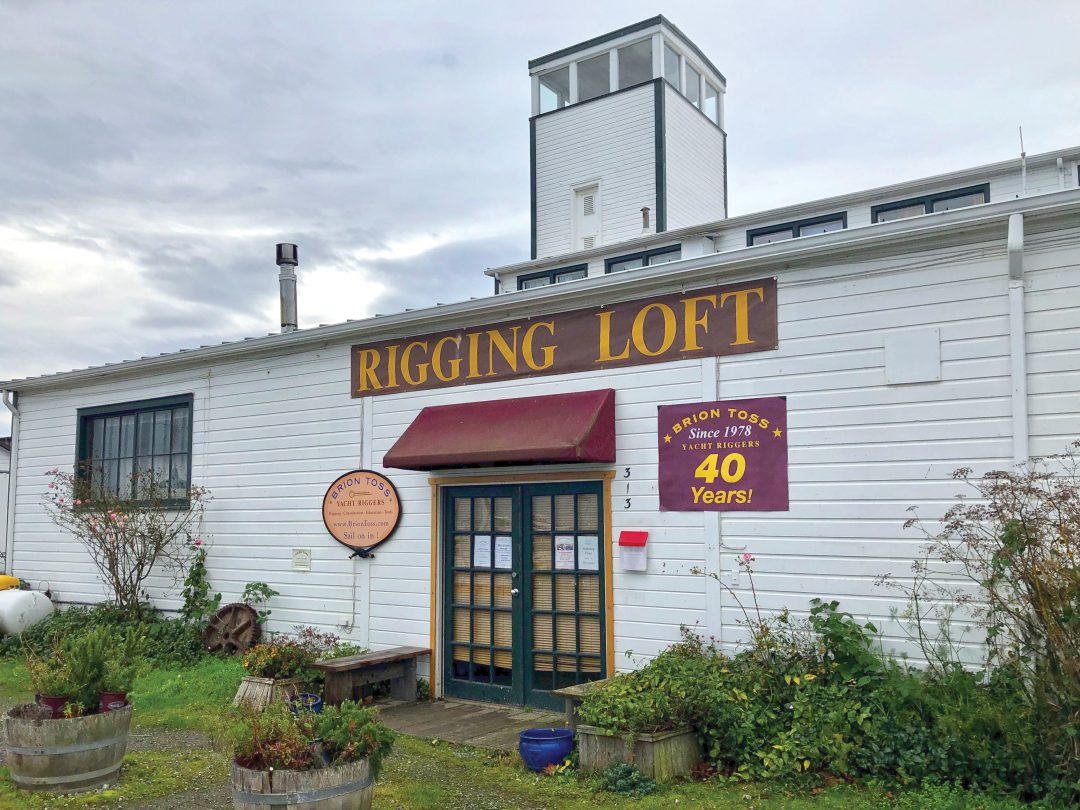
Brion Toss Yacht Riggers office and workshop at historic Point Hudson Marina in Washington state.
A Timeless Shop
Brion Toss Yacht Riggers was founded in 1978 in Port Townsend. Brion was part of a generation of young people who began settling in the faded, historic Victorian seaport town at the time. Like many of them, he was interested in applying the skills and craftsmanship of traditional marine trades to inform, shape, and improve the future of boats and boating.
He eventually set up shop at Point Hudson, a basin on the west end of downtown surrounded by Depression-era white clapboard buildings that were built for the federal government. These historic buildings make Point Hudson one of the most picturesque marinas on the Salish Sea.

A view of the office at Brion Toss Yacht Riggers.
It is always a treat to navigate through the dogleg entrance to Point Hudson and see the basin open up before you. There on the west side sits one of the most iconic of those buildings — a long, two-story wooden structure that served as a Navy carpentry shop during World War II and still sports a signal tower on its south side.
Almost every time I tied up at the marina, I would wander over to that building and walk through the old pane-glass door to Brion’s workshop and office. If Brion were around, he’d always have a few minutes to chat, and inevitably, show me something interesting he was working on.
The space felt timeless, built with thick wooden beams and boards, a small woodstove taking the chill off in colder months. Specialized tools, storage, and workbenches surround the shop. A century-old Willits canoe that belonged to his wife’s father hangs from the ceiling overhead. No matter the time of year, it’s the kind of place you just want to while away a long afternoon.
According to Plan
It is hardly surprising, then, that when it finally came time to tackle an overhaul of the mast and rigging in preparation for bluewater sailing on our latest boat, a 1984 Passport 40, there was no question who we wanted to work with.
It was the late fall of 2019, and we had big plans for the spar. After more than 35 years, the Kenyon mast and boom were looking a bit rough. The original white paint had turned into a chalky mess. We definitely needed all new standing rigging and terminals, and it was past time to replace the original jib furling system. All the hardware needed to come off the mast to check for corrosion. And we would be looking at upgrading some areas, including improving the spinnaker pole lift and adding rope clutches.
Our plan was fairly straightforward. We would hire Brion Toss Yacht Rigging to build the new standing rigging and assemble the furler, while my wife and I would tackle refurbishing the mast, with help and guidance from our friend Ethan Holson, an outstanding shipwright. All of this would be done over the winter and spring in the Pacific Northwest.
I reached out to Brion’s shop in early November 2019 to get a final estimate and confirm details and timelines. I was a bit surprised when Ian responded and let me know that he would be managing their end of the project.
Brion, it turned out, had been diagnosed with cancer several months before. For Ian, the development would change the course of his life.
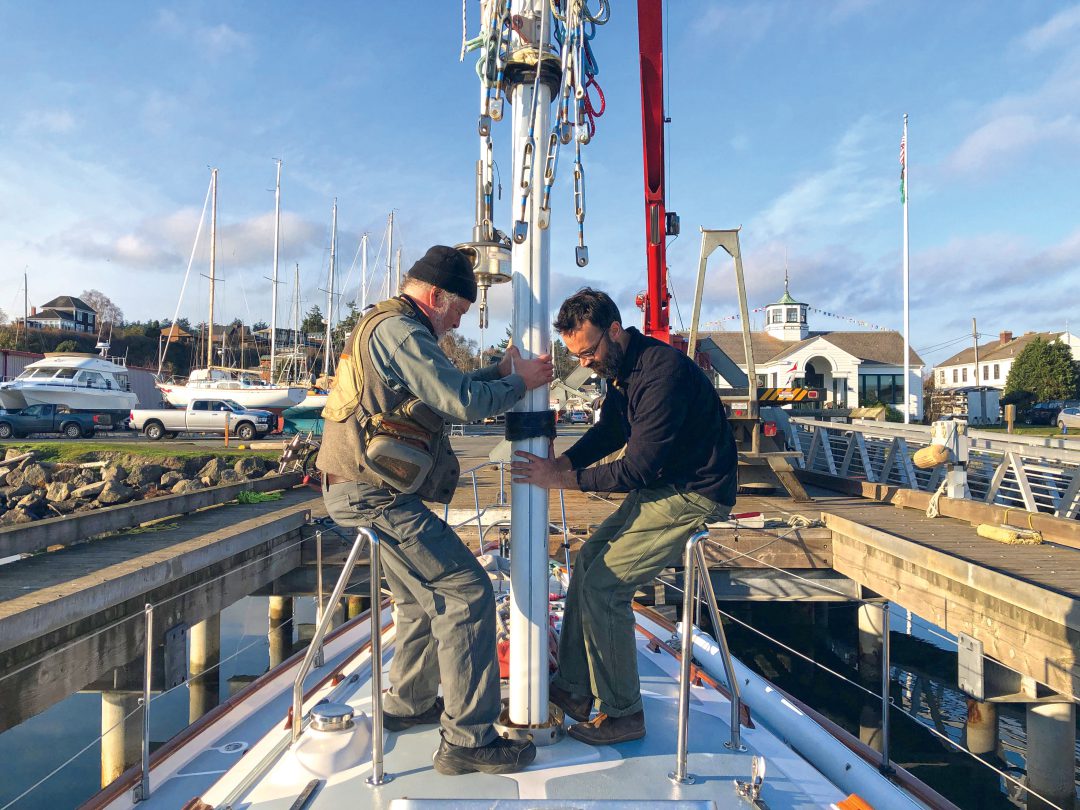
Riggers Brion Toss (left) and Ian Weedman help guide the mast out of the boat on a clear November afternoon.
The First Rule of Rigging
Ian is tall and slender, with dark hair and a beard to match. Affable and thoughtful, he projects a sense of calmness, focus, and sailing knowledge that would be welcome in any boat at sea.
Raised in Longview, Washington, Ian took to sailing early in life. The way some kids will make anything into a gun, Ian would transform bits of wood and cloth into sailboats. He spent time racing with his mom and dad on the Columbia River, dodging freighters and dealing with big winds.
“I’m 44 years old and I tell people I’ve been sailing for 45,” he joked over a glass of scotch at the workshop last year.
At Evergreen State College in the late 1990s, Ian found just about any excuse to get out on the school’s wooden sailing and research vessels, especially Resolute, a 1942 Luders 44 midshipmen Naval training yawl. In the school’s library, Ian came across The Complete Rigger’s Apprentice. He didn’t know who Brion was and didn’t know much about rigging. But the book opened a new world to Ian, one he didn’t want to leave.
In 2000, Ian was aboard Evergreen’s other wooden sailing boat, the 38-foot Seawulff, when it pulled into Point Hudson on one of its many visits to Port Townsend. A classmate stuck his head down below and called out to him. “Hey Ian, that guy whose book you’re always reading is walking down the dock.”
Ian was 25 at the time and still enrolled at Evergreen. But that dockside conversation with Brion led to an apprenticeship, a move to Port Townsend, and a clear calling in life. He would be a rigger.
For Ian, it was the “art, the physics, the math, the history, and the tradition” that drew him deeper into his trade. Under Brion, he learned that the first rule of rigging is fair leads. After that, there were no rules. The improvising, the problem-solving, the careful engineering reminded him of jazz music. And he loved it all.
Learning under Brion was a joy, but it was something to take seriously. He learned the correct and safe way to do the jobs of a rigger, whether climbing masts or splicing an eye in double-braid rope. He would learn the shear strength of bolts and the history of the craft in which he was quickly growing into a journeyman.
The two built a strong working relationship over the ensuing years. And it was clear that in Ian, Brion saw someone who could become a partner in the business, someone who might carry on the work he had started in the late 1970s.
Brion was a great teacher, Ian recalled, but the most important lesson Brion taught him was to “ask the right questions.”
Ian, though, had to leave before he could return. An offer to bring his rigging expertise to a company building high-end treehouses led him to 10 years of traveling the world, including stints in Japan, Hawaii, and Costa Rica. Ian even took part for one season of the TV show Treehouse Masters.
While building treehouses, Ian further refined and developed his skills, working with engineers, architects, and climbing technicians on projects that rounded out his understanding of what rigging could do.
Throughout that period, he stayed in touch with Brion and occasionally found time to work on jobs with him. Eventually, growing tired of the extensive travel required with extreme treehouse construction, Ian decided to return to boat rigging full time and set up his own shop servicing boats in California and Oregon.
In 2014, he got a call from Brion’s wife and business partner, Christian Gruye. She and Brion were looking forward to retiring and wanted a partner who could eventually take over the business. Brion was clear that the person had to be someone he had trained. And the person they both wanted was Ian.
For Ian, it wasn’t the right time. He was focused on building his own business and a more settled lifestyle. But the conversation would surface again in fits and starts over the following few years. When Ian eventually felt the time was right, he wrote an email telling Brion that he wanted to talk details and get the ball rolling.
To his surprise, he didn’t get a reply. One day in June 2019, he opened his inbox to read a response that shook him to his core. “Very sorry,” Ian recalled Brion writing. “I’m not well. Please reach out to Christian.”
After talking to Christian, Ian understood that neither Brion nor the business was doing well and they needed help right away. Ian finished up his open rigging projects, packed up his home, and moved back to Port Townsend.
Hanging In the Balance
A few months later, on an uncharacteristically beautiful day in late November, I maneuvered my boat into the haulout slip at Point Hudson, where a portable crane stood ready to pluck the mast. Brion and Ian were standing up on the dock, Brion in his trademark rigger’s vest and Ian in a blue wool overshirt.
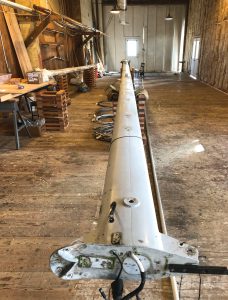
Marty’s mast in the cavernous mast room at Brion Toss Yacht Riggers. The shrouds and stays are coiled below it.
Despite his ongoing cancer treatments, Brion looked much like his old self. Ian easily climbed the mast to secure the lifting strap. The two worked with practiced ease removing the rigging pins and securing the shrouds and stays.
The engine on the crane revved and the lifting strap began to take up the load. But the mast was reluctant to move. It needed a little convincing, but the mast seal finally released its grip with a bang and the spar began to rise. Brion and Ian, positioned on opposite sides of the mast, gently guided it skyward, inch by inch, into the air, where it hung balanced in exquisite uncertainty before being slowly lowered to the ground.
I relished the next few days in Brion’s workshop. The jumble of rigging wires was removed one by one. Critical areas around the spreader bases and tangs were inspected and found sound. Ian, Brion, and I measured the shrouds and stays—and then measured them again. I managed to get almost every piece of hardware off the mast, most screws giving up their decades-old grip with only a modicum of fight. All except for one, that is, the last of eight flatheads securing the rigid boom vang’s mast fitting.
Brion pulled an old wooden dining room chair up to the fitting and sat down. I watched as he went through his process of breaking that corrosive bond between stainless and aluminum. It was late after- noon, the winter sky outside a deep shade of near-night blue. The chair was positioned under one of the bright spotlights in the otherwise dark and cavernous mast room.
Eventually, Brion resorted to drilling off the head of the fastener. The fitting was free, but the hole for that screw was now useless, positioned as it was over the now permanently fixed remnants of the screw shaft. Barely giving it a moment’s thought, Brion drilled a new hole in the fitting, countersunk it, and then tapped a corresponding hole in the mast. Improvised like a jazz solo, the solution was as strong as new.
A New Chapter
As the winter progressed, Ian and Brion built the new stays and shrouds and then waited patiently for my wife and I to make progress on painting the mast. Grinding any spots of corrosion and prepping the mast for paint could be done outside as weather allowed. But to prime and paint, we needed a covered location out of the elements.
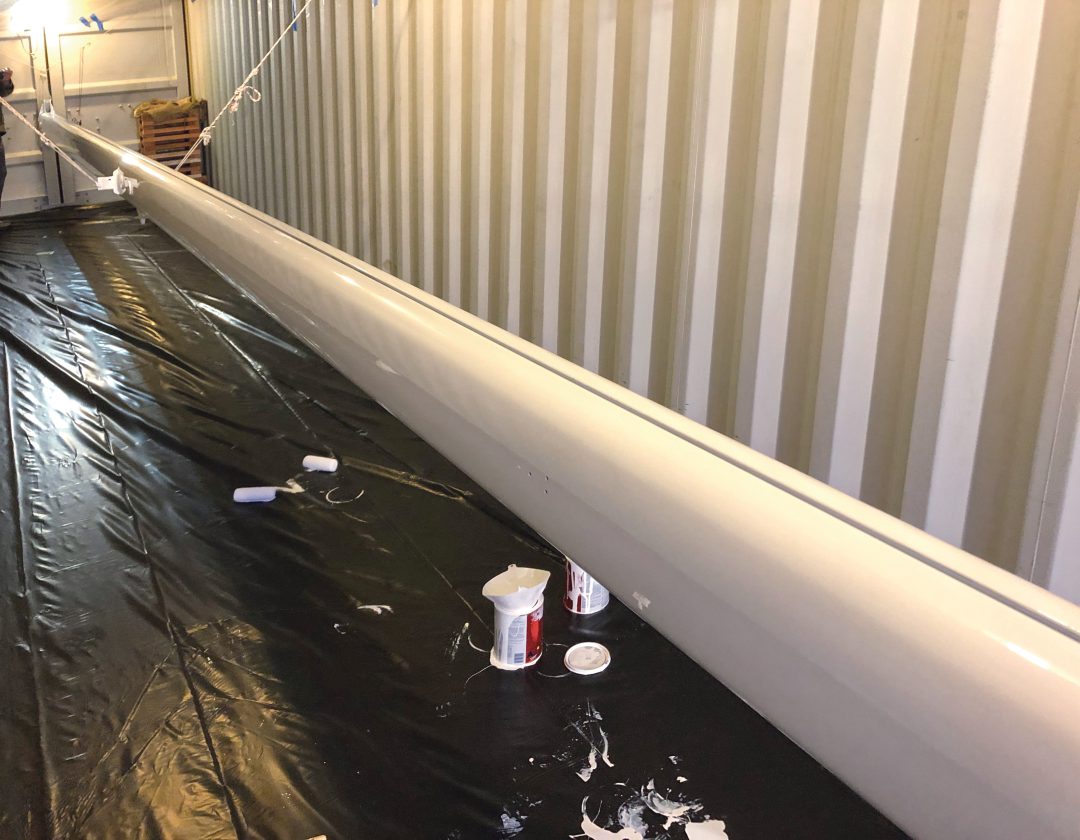
The newly painted mast hanging in the shipping container.
There were no dedicated mast painting rooms anywhere in Port Townsend, so like Ian and Brion, we improvised. After one failed approach, we landed on renting a 40-foot shipping container and built an extension out of wood, shrink wrap, and tarps to cover the portion of mast that stuck out the end. This worked perfectly for us.
Then COVID hit and Port Townsend, like communities everywhere, seemed to fall into slow motion. Through the spring, Deborah and I kept to ourselves, spending weekends carefully guide-coating, hand- sanding, priming, and eventually painting the mast and boom.
Spring arrived and the days grew longer and warmer. By May, our mast and boom emerged from the container glossy, white, smooth—transformed. New and refurbished hardware was reinstalled, with proper barriers to prevent corrosion.
With concerns about COVID raging, we didn’t get a chance to see Brion much after those early days of working on the project. The last time we spoke, he was in his office in good spirits, getting ready to take a lesson on electric bass guitar from a good friend.
On June 6, 2020, Brion passed away from cancer.
Through the deep grief that spread through the community of people who knew Brion, the work that he started somehow went on. Ian was joined at the shop by two other long-time riggers and former apprentices, Jen Bates and Matt Fahey. Together, they had decades of experience working alongside Brion.
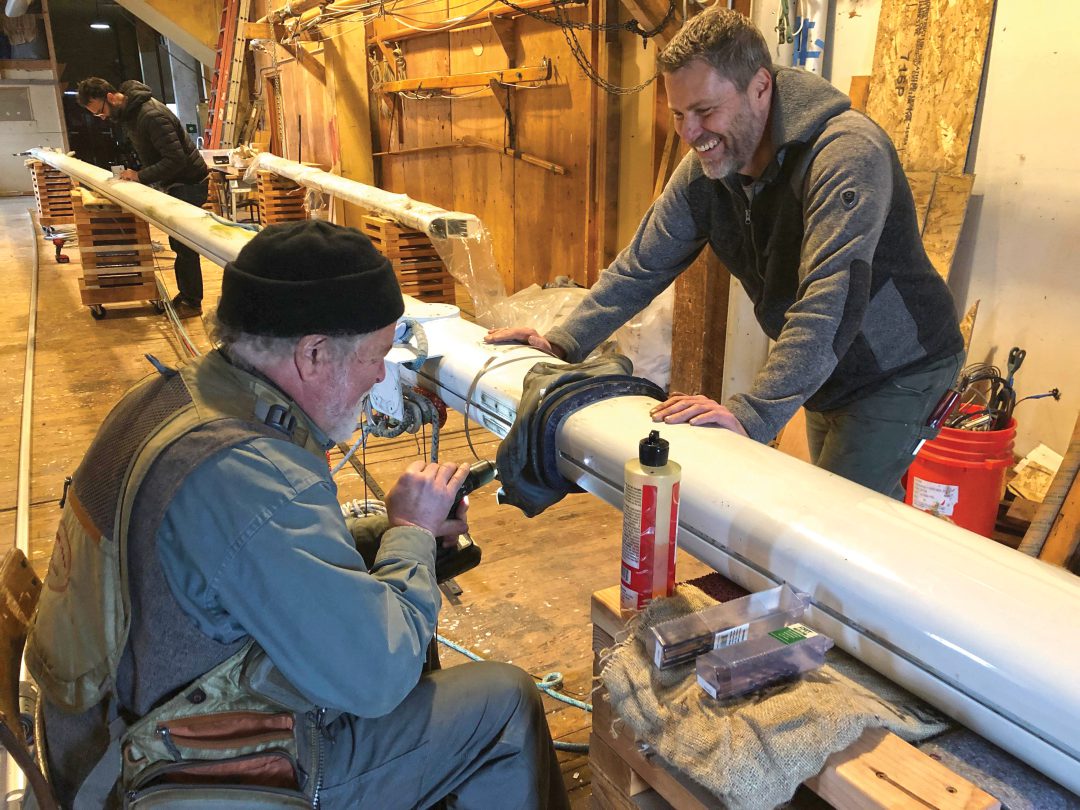
Rigger Brion Toss (seated) drills and taps a new hole in the mast while Marty smiles at one of his jokes. In the background, Ian Weedman inspects the spreader tang.
Just 10 days after Brion passed, I once again found myself maneuvering our boat into the haulout slip. This time, Jen, Matt, and Ian were the ones to put the mast on its two-wheeled cart and walk it slowly, carefully out of the gravel parking lot, down that narrow, one-way road, past the two houses and that giant Herreshoff cleat.
The three worked together with practiced ease as they prepped the mast for stepping. They methodically checked to make sure there would be no surprises— the shrouds and stays would not tangle and the lifting strap was securely attached. Just the way Brion had taught them.
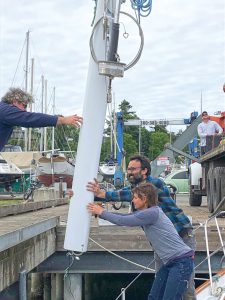
Rigger Matthew Fahey hands the mast off to riggers Jen Bates (foreground) and Ian Weedman. It is the first mast the shop had stepped after the passing of founder Brion Toss.
Then the crane engine revved and the mast began to lift skyward again. It hovered overhead, then glided slowly over to the boat. Christian was there taking pictures, watching proudly as the shop’s crew worked. Ian, Jen, and Matt carefully guided the mast down and into the boat, setting it firmly on its step. The shrouds and stays were the exact right length.
It was something they had done countless times. But this mast, this time, was different.
When all the initial work was done and the mast and standing rigging were securely in place, everyone joined together for a group photo. It was a bittersweet moment. They smiled and seemed satisfied with a job well done.
An era and an icon had passed. On that day, a new chapter had begun.
Postscript
It has been more than two years since the mast was stepped on our Passport 40. The rig and mast have performed flawlessly, including on a nearly six-week circumnavigation of Vancouver Island in the summer of 2022.
Under Ian and Christian’s leadership, and with the continued help of Jen and Matt, Brion Toss Yacht Riggers is as busy as it has ever been at its office and workshop in Point Hudson. And a new crop of apprentices—including Jen’s son, Chance Bates —who are eager to learn the art and science of rigging have already signed onboard, ready to carry forward a legacy that began decades ago.
Brion would be proud.

